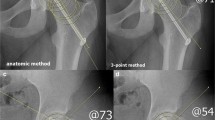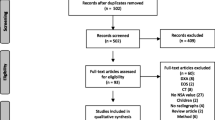Abstract
Objective
Slipped capital femoral epiphysis (SCFE) is a hip disorder where the femoral head slips relative to the neck at the physis. Appropriate treatment of SCFE depends on the severity of the slip, commonly categorised using the Southwick (SW) angle. The SW angle is measured in the frog-lateral leg position, which can be painful and potentially unattainable for patients. The purpose of this study is to determine how errors in frog-lateral radiograph positioning affect measured SW angles and slip classifications.
Methods
Models of SCFE hips were produced from one CT scan of a normal hip; 360 deformities were created. SW angles were measured from a simulated frog-lateral position. Femoral lateral head-neck angles (LHNA; equivalent to SW in incorrect frog-lateral plane) were measured over a range of 837 incorrect frog-lateral leg positions with positioning errors in flexion and/or internal/external rotation.
Results
Seventy-six per cent of all imaging position-deformity combinations had error in the reported angle (>1° difference between LHNA and SW). Of those, 70% had <5°, 24% had 5° to 10°, and 6% had >10° of error from the actual SW angle. Three per cent of LHNAs that had >10° error resulted from <10° of positioning error.
Conclusions
If the patient is limited in flexion or external rotation, more diagnostic testing should be considered if error in the reported slip measurement would affect treatment decisions or if accurate severity classification is needed for research. Small positioning errors in moderate and severe slips can cause a > 10° LHNA error; additional three-dimensional imaging should be considered.



Similar content being viewed by others
References
Wu GS, Pollock AN. Slipped capital femoral epiphysis. Pediatr Emerg Care. 2011;27(11):1095–6.
Gholve PA, Cameron DB, Millis MB. Slipped capital femoral epiphysis update. Curr Opin Pediatr. 2009;21(1):39–45.
Novais EN, Millis MB. Slipped capital femoral epiphysis: prevalence, pathogenesis, and natural history. Clin Orthop Relat Res. 2012;470(12):3432–8.
Manoff EM, Banffy MB, Winell JJ. Relationship between body mass index and slipped capital femoral epiphysis. J Pediatr Orthop. 2005;25(6):744–6.
Abraham E, Gonzalez MH, Pratap S, Amirouche F, Atluri P, Simon P. Clinical implications of anatomical wear characteristics in slipped capital femoral epiphysis and primary osteoarthritis. J Pediatr Orthop. 2007;27(7):788–95.
Sonnega RJA, van der Sluijs JA, Wainwright AM, Roposch A, Hefti F. Management of slipped capital femoral epiphysis: results of a survey of the members of the European Paediatric Orthopaedic society. J Child Orthop. Dec. 2011;5(6):433–8.
Jarrett DY, Matheney T, Kleinman PK. Imaging SCFE: diagnosis, treatment and complications. Pediatr Radiol. 2013;43(Suppl 1):S71–82.
Westhoff B, Ruhe K, Weimann-Stahlschmidt K, Zilkens C, Willers R, Krauspe R. The gait function of slipped capital femoral epiphysis in patients after growth arrest and its correlation with the clinical outcome. Int Orthop. May 2012;36(5):1031–8.
Loder RT. Controversies in slipped capital femoral epiphysis. Orthopedic Clinics of North America. 2006;37:211–221.
Jones CE, Cooper AP, Doucette J, Buchan LL, Wilson DR, Mulpuri K, d’Entremont AG. Relationships Between Severity of Deformity and Impingement in Slipped Capital Femoral Epiphysis. J Pediatr Orthop. 2015;91(5):360–4.
Rao KN, Joseph B. Value of measurement of hip movements in childhood hip disorders. J Pediatr Orthop. 2001;21(4):495–501.
Lehmann TG, Vetti N, Laborie LB, Engesæter IØ, Engesæter LB, Rosendahl K. Intra- and inter-observer repeatability of radiographic measurements for previously slipped capital femoral epiphysis at skeletal maturity. Acta Radiologica. 2014;(5):587–591.
Kay RM, Jaki KA, Skaggs DL. The effect of femoral rotation on the projected femoral neck-shaft angle. J Pediatr Orthop. 2000;20(6):736–9.
Acknowledgements
This study was supported by a Microgrant from the Rare Disease Foundation and an Undergraduate Student Research Award from Engineers in Scrubs.
Author information
Authors and Affiliations
Corresponding author
Ethics declarations
Ethics board approval was obtained from our institution for this study. All procedures performed in studies involving human participants were in accordance with the ethical standards of the institutional and/or national research committee and with the 1964 Helsinki Declaration and its later amendments or comparable ethical standards.
Conflict of interest
The authors declare that they have no conflict of interest.
Rights and permissions
About this article
Cite this article
Jones, C.E., Cooper, A.P., Doucette, J. et al. Southwick angle measurements and SCFE slip severity classifications are affected by frog-lateral positioning. Skeletal Radiol 47, 79–84 (2018). https://doi.org/10.1007/s00256-017-2761-z
Received:
Revised:
Accepted:
Published:
Issue Date:
DOI: https://doi.org/10.1007/s00256-017-2761-z




